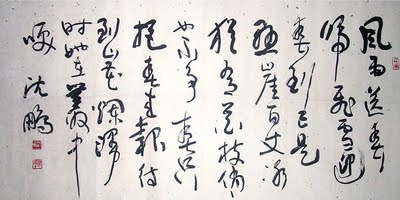Shen Peng, born in 1931 and a native of Jiang Yin of Jiangsu province, is a famous calligrapher, painting commenter, poet and copy editor. He started learning Chinese painting and calligraphy at very young age. Later, he learned Chinese painting, calligraphy, poetry and classics from a number of Juren (scholars who passed the imperial provincial examinations) of the late Qin dynasty, such as Zhang Songguang.
In 1948, he entered the Zhong Zheng University (currently known as Jiangxi Normal University) to study literature in the Chinese Language department. Later, he switched to study journalism.
Before his retirement, he held a number of senior posts in the governmental units and organisations, such as the deputy president of the China Federation of Literary and Art Circles, the president of the China Calligraphers Association, the advisor of the China Painting Press and the chief editor of “Chinese Painting and Calligraphy” magazine.
He is famous in cursive script, and his calligraphy in cursive script refects the sentiments of the comptemporary age and shows his personal style. He is equally skilful in other scripts such as the clerical and regular scripts, and they are evauluated highly in China and abroad. He has written more than 15000 pieces of calligraphic works, of which about 1000 pieces are written for magazines, newspaper, congratulatory messages for various exhibitions, and for inscribing on horizontal boards. His works can be found all over China at such places as the Great Hall of the People, the Zhongnanhai – the central headquarters for the Chinese government, Hotels. They are also collected widely outside China, inscribed on stones and wooden boards at various natural scenaries and places of interest in Hang Zhou, Zheng Jiang, Shanghai, Nanjing, Jinan, Mount Ermei, the Three Gorges, Lao Shan, Helan Shan, Hainan, and Beijing etc.
Zhao Puchu praised Shen Peng for his calligraphy, saying ‘his works is comparable to if not better than that of the ancient masters, and I admire them a great deal.’ Qi Gong commented: ‘I have known him for more than 30 years, and notice that he always has something unique to offer when comes to critics on arts.’ ‘None of his calligraphy of cursive script follows a set pattern. We say that it is important to be creative in arts. We have found this his art works.’
He has received numerous awards at home and abroad for his contributions to the development and promotion of arts and culture.
.
沈鹏于1931年出生于江苏江阴,是当今中国著名书法家、美术评论家、诗人、编辑出版家。斋名介居。幼年始习字画。少年从章松厂(清末举人)等人学习古文、诗词、中国画、书法。1948年,沈老进入江西师范大学前身中正大学中文系攻读文学,后来转学新闻专业。
他在政府单位与机构担任不少要职,包括中国文联副主席、中国书法家协会代主席、中国美术出版总社顾问以及《中国书画》主编。
书法长行草,有强烈的时代风貌与个人风格,书体兼及隶、楷多种面貌,受到国内外高度评价。历年创作书法作品15000件以上,其中为图书报刊、展览题耑题贺以及题写匾额1000件以上。为人民大会堂、中南海、亚运会五洲大酒店等重要场所书写巨幅。其书法作品遍及亚、欧、美各大洲,刻于名胜古迹者有杭州、苏州、镇江、上海、南京、济南、郑州、峨嵋山、三峡、千山、崂山、贺兰山、海南、北京等地。
赵朴初赞扬沈鹏书法‘大作不让明贤,至所欣佩’。启功说:‘仆私交沈鹏先生逾30载,观其美术评论之作,每有独到之处。’‘所作行草,无一旧时窠臼,艺贵创新,先生得之。’
他对艺术与文化的发展与推动,获得了不少荣誉与奖状。
.










































